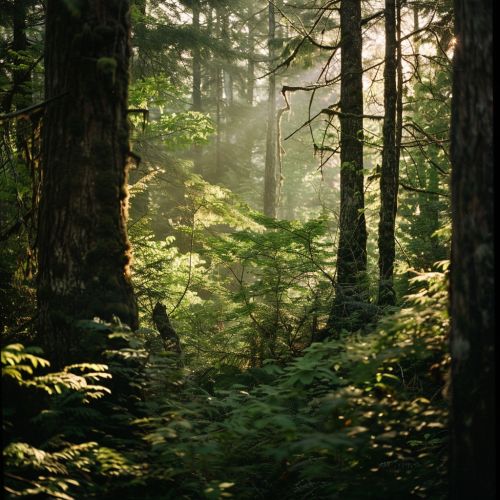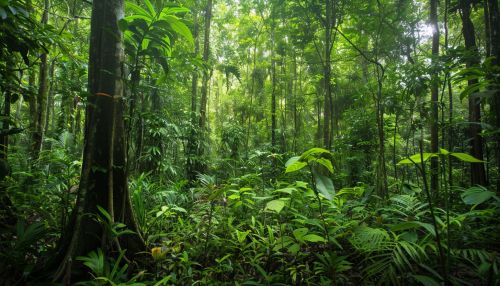Earth's Ecosystem: Difference between revisions
(Created page with "== Introduction == Earth's ecosystem is a complex and dynamic network of living organisms and their physical environment. It encompasses a wide range of habitats, from the deepest oceans to the highest mountains, and includes diverse communities of plants, animals, fungi, and microorganisms. The interactions among these organisms and their surroundings are fundamental to the functioning of the planet's biosphere. This article delves into the intricate details of Earth's...") |
No edit summary |
||
| Line 59: | Line 59: | ||
* **Tundra**: Cold, treeless regions found in the Arctic and Antarctic, with a short growing season and permafrost. | * **Tundra**: Cold, treeless regions found in the Arctic and Antarctic, with a short growing season and permafrost. | ||
[[Image:Detail-91837.jpg|thumb|center|Dense forest with tall trees and lush undergrowth.|class=only_on_mobile]] | |||
[[Image:Detail-91838.jpg|thumb|center|Dense forest with tall trees and lush undergrowth.|class=only_on_desktop]] | |||
=== Aquatic Ecosystems === | === Aquatic Ecosystems === | ||
Latest revision as of 10:21, 19 June 2024
Introduction
Earth's ecosystem is a complex and dynamic network of living organisms and their physical environment. It encompasses a wide range of habitats, from the deepest oceans to the highest mountains, and includes diverse communities of plants, animals, fungi, and microorganisms. The interactions among these organisms and their surroundings are fundamental to the functioning of the planet's biosphere. This article delves into the intricate details of Earth's ecosystem, exploring its components, processes, and the critical role it plays in sustaining life.
Components of Earth's Ecosystem
Biotic Components
The biotic components of an ecosystem include all living organisms, which can be categorized into producers, consumers, and decomposers.
- **Producers**: These are autotrophic organisms, primarily plants and algae, that convert solar energy into chemical energy through the process of photosynthesis. They form the base of the food web and provide energy for all other trophic levels.
- **Consumers**: These are heterotrophic organisms that obtain energy by consuming other organisms. They can be further divided into:
* **Primary consumers**: Herbivores that feed on producers. * **Secondary consumers**: Carnivores that prey on herbivores. * **Tertiary consumers**: Apex predators that feed on secondary consumers.
- **Decomposers**: These organisms, including bacteria and fungi, break down dead organic matter, recycling nutrients back into the ecosystem.
Abiotic Components
The abiotic components of an ecosystem include all non-living elements that influence living organisms. These components include:
- **Climate**: The long-term patterns of temperature, humidity, wind, and precipitation in an area.
- **Soil**: The upper layer of the earth in which plants grow, consisting of organic matter, minerals, gases, liquids, and organisms.
- **Water**: Essential for all life forms, water is a major component of ecosystems, influencing the distribution and activities of organisms.
- **Nutrients**: Chemical elements and compounds that organisms need to grow and reproduce, such as nitrogen, phosphorus, and potassium.
Ecosystem Processes
Energy Flow
Energy flow in an ecosystem follows a unidirectional path from the sun to producers and then through various trophic levels. The efficiency of energy transfer between trophic levels is typically low, with only about 10% of the energy being passed on to the next level. This phenomenon is known as the 10% rule.
Nutrient Cycling
Nutrient cycling is the movement and exchange of organic and inorganic matter back into the production of living matter. Key nutrient cycles include:
- **Carbon Cycle**: The movement of carbon between the atmosphere, hydrosphere, lithosphere, and biosphere.
- **Nitrogen Cycle**: The process by which nitrogen is converted between its various chemical forms, essential for the synthesis of proteins and nucleic acids.
- **Phosphorus Cycle**: The movement of phosphorus through the lithosphere, hydrosphere, and biosphere, crucial for the formation of DNA, RNA, and ATP.
Ecological Succession
Ecological succession is the process by which the structure of a biological community evolves over time. There are two main types:
- **Primary succession**: Occurs in lifeless areas where there is no soil, such as after a volcanic eruption.
- **Secondary succession**: Occurs in areas where a disturbance has destroyed a community but left the soil intact, such as after a forest fire.
Types of Ecosystems
Terrestrial Ecosystems
Terrestrial ecosystems are land-based ecosystems and include:
- **Forests**: Dominated by trees, forests are classified into tropical, temperate, and boreal types based on climate and geography.
- **Grasslands**: Characterized by vast open spaces with grasses as the dominant vegetation, including savannas and prairies.
- **Deserts**: Arid regions with sparse vegetation, adapted to extreme temperatures and low water availability.
- **Tundra**: Cold, treeless regions found in the Arctic and Antarctic, with a short growing season and permafrost.


Aquatic Ecosystems
Aquatic ecosystems are water-based and include:
- **Freshwater Ecosystems**: Rivers, lakes, streams, and wetlands, characterized by low salt concentration.
- **Marine Ecosystems**: Oceans, seas, and coral reefs, with high salt concentration and diverse marine life.
Transitional Ecosystems
Transitional ecosystems, also known as ecotones, are areas where two different ecosystems meet and integrate. Examples include estuaries, where freshwater meets saltwater, and mangroves, which are coastal wetlands.
Human Impact on Ecosystems
Human activities have significantly altered Earth's ecosystems, leading to habitat destruction, pollution, climate change, and biodiversity loss. Key impacts include:
- **Deforestation**: The clearing of forests for agriculture, logging, and urban development, resulting in habitat loss and increased carbon emissions.
- **Pollution**: The introduction of harmful substances into the environment, affecting air, water, and soil quality.
- **Climate Change**: The alteration of global climate patterns due to increased greenhouse gas emissions, affecting temperature, precipitation, and sea levels.
- **Overexploitation**: The unsustainable harvesting of resources, such as overfishing and hunting, leading to population declines and extinctions.
Conservation and Restoration
Efforts to conserve and restore ecosystems are crucial for maintaining biodiversity and ecosystem services. Strategies include:
- **Protected Areas**: Establishing national parks, wildlife reserves, and marine protected areas to safeguard habitats and species.
- **Sustainable Practices**: Promoting sustainable agriculture, forestry, and fishing practices to reduce environmental impact.
- **Restoration Projects**: Rehabilitating degraded ecosystems through reforestation, wetland restoration, and invasive species control.
- **Legislation and Policies**: Enacting laws and regulations to protect endangered species and habitats, and to mitigate pollution and climate change.
